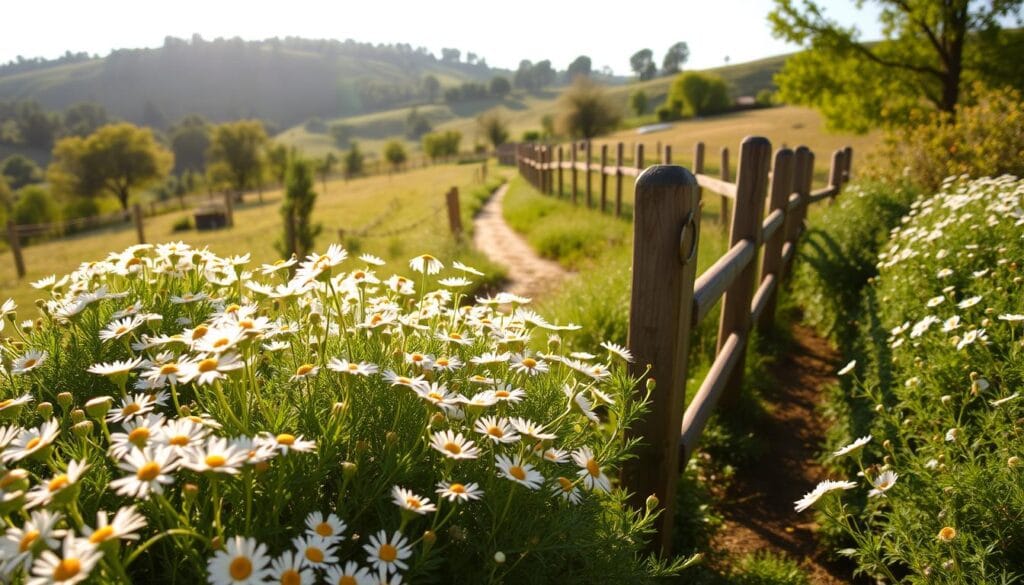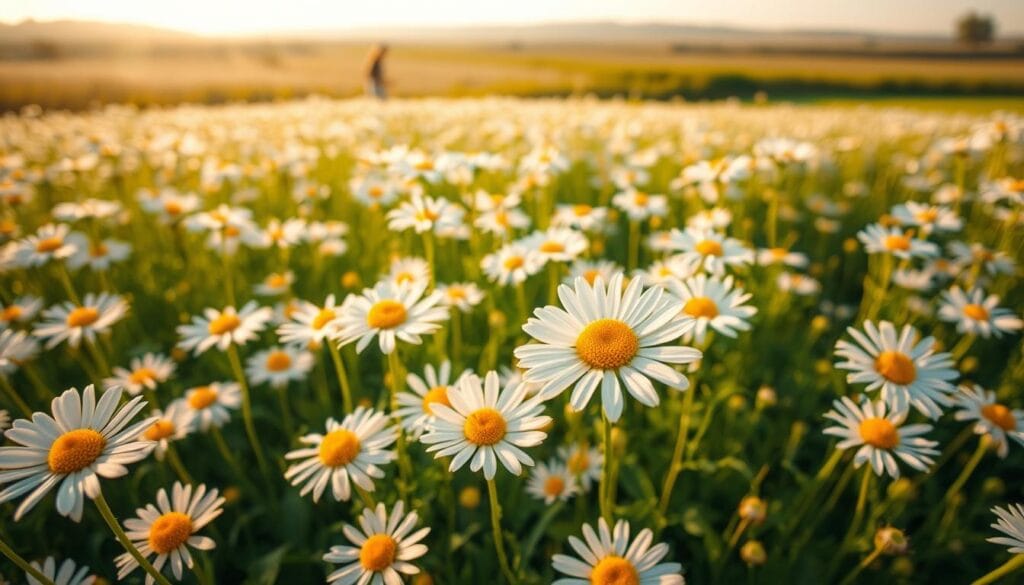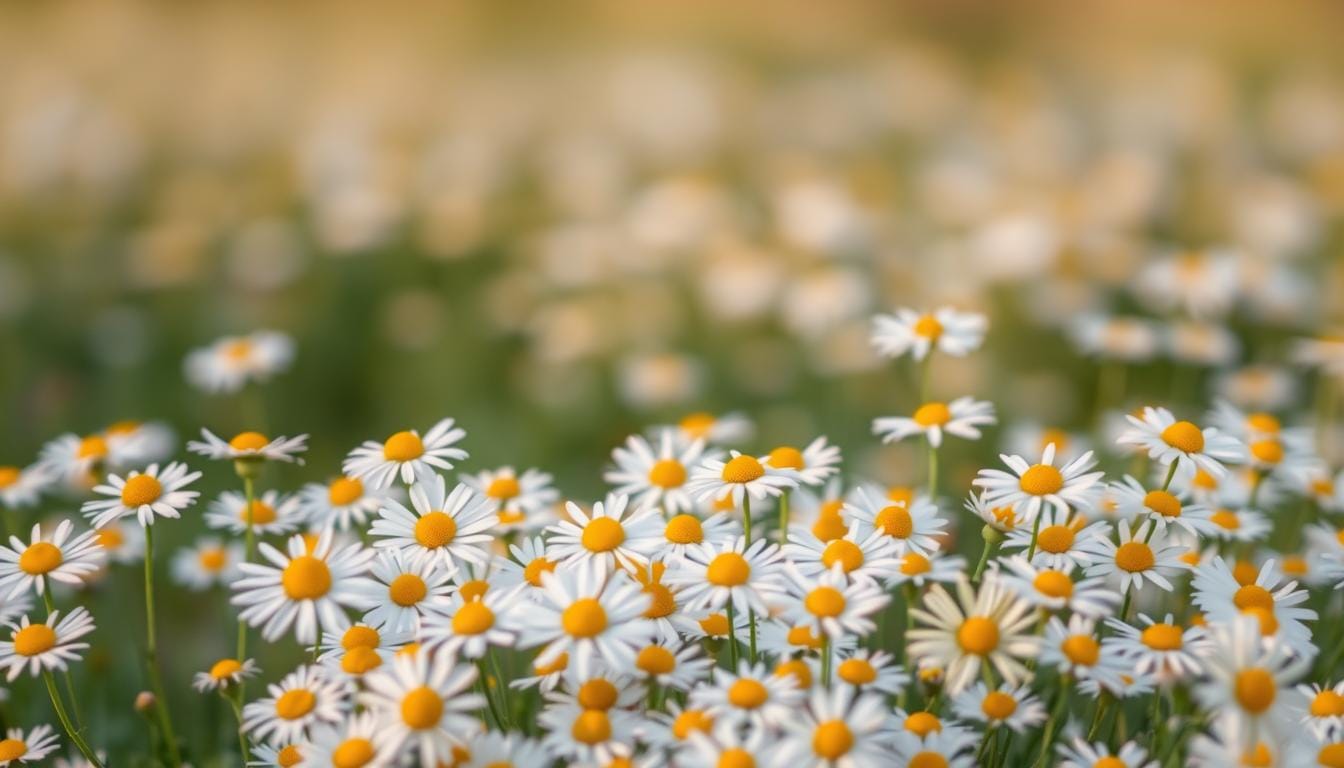As Hippocrates once said, “Nature itself is the best physician.” This timeless wisdom rings true when it comes to the humble chamomile plant. Known for its delicate flowers and soothing properties, chamomile has been cherished for centuries as both a garden herb and a natural remedy.
Belonging to the Asteraceae family, this plant shares lineage with sunflowers and echinacea. Its name, derived from the Greek words for “ground apple,” hints at its pleasant, apple-like scent. Historically, chamomile was used in ancient Egypt for its healing properties, and today, it remains a staple in modern herbal practices.
Chamomile is versatile. It’s commonly used in teas, tinctures, and lotions. Its anti-inflammatory and antioxidant properties make it a favorite for stress relief, skin care, and digestive aid. Whether you’re growing it in your garden or brewing it into a calming tea, this plant offers endless benefits.
Key Takeaways
- Chamomile is a dual-purpose plant, ideal for gardens and herbal remedies.
- Two main varieties include German and Roman chamomile.
- Its historical use dates back to ancient Egypt.
- Offers medicinal benefits like stress relief and skin care.
- Commonly used in teas, tinctures, and lotions.
- Easy to grow and thrives in well-drained soil.
Why Grow Chamomile Seeds?
Adding chamomile to your garden brings beauty and functionality. This versatile herb is not only easy to grow but also offers a range of benefits that make it a must-have for any gardener. Whether you’re looking to enhance your garden’s aesthetic or enjoy its soothing properties, chamomile is a perfect choice.

One of the biggest advantages of growing chamomile is its economic value. A single packet contains 895-900 seeds, providing a high yield compared to the cost of store-bought tea. This makes it a budget-friendly option for those who enjoy herbal remedies.
Chamomile is also a pollinator-friendly plant. Its delicate flowers attract bees and butterflies, supporting your local ecosystem. By planting this herb, you’re not just beautifying your garden but also contributing to environmental health.
Another benefit is its role in companion planting. Chamomile enhances the growth of nearby vegetables and ornamentals, making it a valuable addition to any garden layout. Its ability to thrive in various conditions, including containers, adds to its appeal.
With its drought tolerance and adaptability, chamomile is a low-maintenance herb that rewards you with multiple harvests per season. Whether you’re planting in spring or fall, it’s a reliable choice for gardeners of all skill levels.
For those looking to explore different varieties, Eden Brothers offers a selection of three types to suit diverse growing needs. From compact borders to sprawling herb gardens, chamomile proves to be both functional and visually stunning.
Growing Chamomile Seeds Successfully
Growing this versatile herb can transform your garden into a haven of beauty and wellness. With the right techniques, you can enjoy a bountiful harvest of delicate flowers that are perfect for tea or other uses. Let’s explore the steps to ensure your plants thrive.
When and Where to Plant
Timing is crucial for successful growth. Spring is the ideal season to plant, as the warmer soil encourages germination. Choose a sunny spot with well-drained soil to give your plants the best start.
For fall planting, ensure the area is protected from early frosts. While spring offers longer daylight hours, fall planting can still yield results if done carefully.

Step-by-Step Planting Guide
Start by preparing the soil. Loosen it to a depth of 6 inches and mix in organic matter for added nutrients. Scatter the seeds lightly and cover them with a thin layer of soil.
Water gently at the base to avoid disturbing the seeds. Keep the soil moist but not waterlogged. If starting indoors, harden the plants over 7 days before transplanting them outside.
Care and Harvesting Tips
Regular care ensures healthy growth. Pinch the stems when they reach 6 inches to encourage bushiness. Use the finger-test method to check soil moisture—water only when the top inch feels dry.
Harvest the flowers mid-morning, after the dew has dried. Use scissors to cut the blooms, leaving some foliage intact. Dry the flowers in a well-ventilated area for long-term storage.
If pests appear, use neem oil as a natural solution. With proper care, you’ll enjoy multiple harvests throughout the season.
Companion Plants for Chamomile
Pairing chamomile with the right plants can boost your garden’s health and beauty. Companion planting not only enhances growth but also deters pests and improves soil quality. Here’s how to create a thriving ecosystem with chamomile and its ideal partners.
Some of the best companions for chamomile include bee balm, phlox, and Black Eyed Susan. These flowers not only add vibrant colors but also attract pollinators like bees and butterflies. Together, they create a lively and productive garden space.
Chamomile is also a natural pest deterrent. It repels cabbage moths, making it a great neighbor for brassicas like broccoli and kale. Additionally, it enhances the oil production of basil, another popular herb. This synergy benefits both plants and your overall harvest.
For ornamental pairings, consider cottage garden favorites like lavender and roses. These combinations create a charming aesthetic while promoting healthy growth. Proper spacing is key—allow 12-18 inches between chamomile and its companions for optimal air circulation and root development.
However, avoid planting chamomile near mint family members like spearmint or peppermint. These plants can compete for resources and hinder chamomile’s growth. Instead, focus on compatible species that support each other’s needs.
Here’s a quick guide to chamomile’s top companions:
- Bee Balm: Attracts pollinators and adds vibrant color.
- Phlox: Enhances soil health and complements chamomile’s growth.
- Black Eyed Susan: Thrives in similar conditions and attracts beneficial insects.
- Basil: Benefits from chamomile’s pest-repelling properties.
- Lavender: Creates a visually stunning and aromatic pairing.
- Roses: Adds elegance and thrives alongside chamomile.
- Broccoli: Protected from pests by chamomile’s natural deterrents.
By carefully selecting companion plants, you can create a balanced and thriving garden. Whether you’re growing vegetables, herbs, or ornamentals, chamomile’s versatility makes it a valuable addition to any planting scheme.
Conclusion
Starting your journey with this versatile herb can bring both beauty and wellness to your space. In just one month, you’ll see blooms that are perfect for brewing a calming tea or enhancing your garden’s charm. Growing your own ensures quality and saves you money compared to store-bought options.
At Eden Brothers, you’ll find affordable seed packets starting at $2.49. Their 3¼” x 4½” resealable packaging keeps your purchase fresh for future use. Take advantage of bulk pricing and seasonal discounts to stock up for the year.
Ready to start? Add your favorite varieties to your cart today. Limited stock is available, so don’t wait! Returning customers can log in for exclusive deals and faster checkout.
Whether you’re a beginner or a seasoned gardener, this herb is a rewarding addition to your space. Shop now and enjoy the benefits of homegrown wellness!

5 thoughts on “Chamomile Seeds: Benefits, Uses, and How to Grow Them”